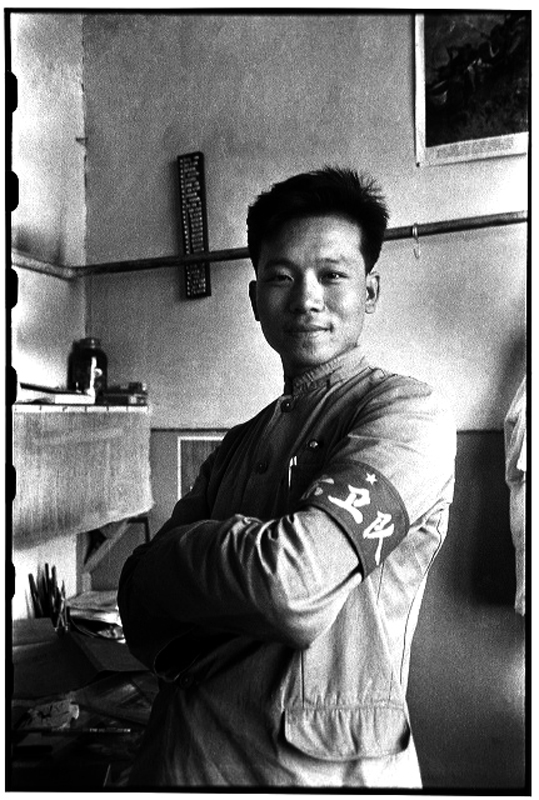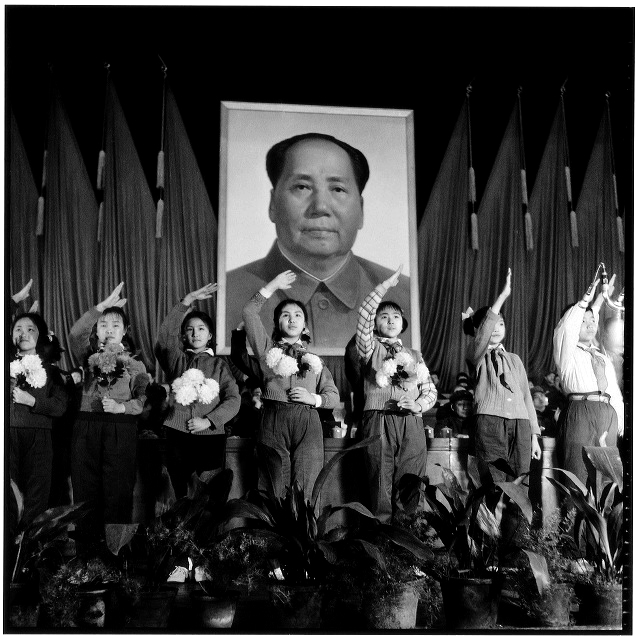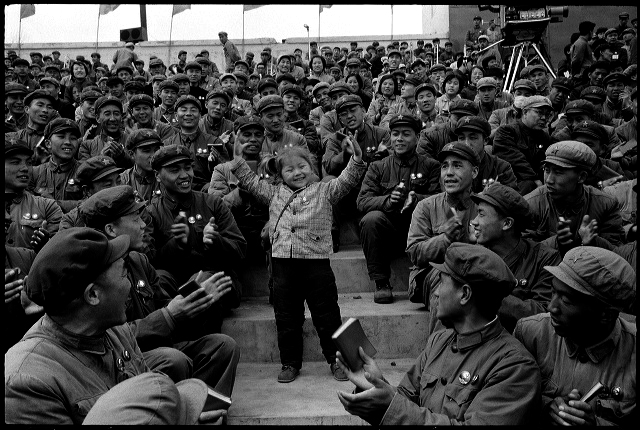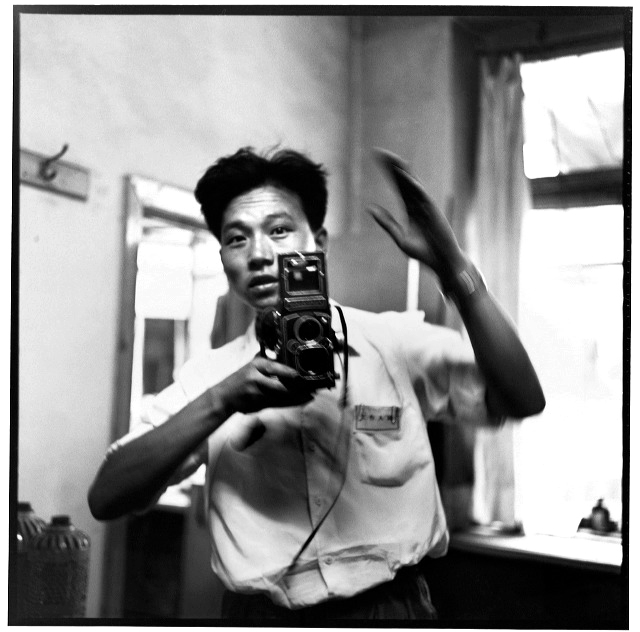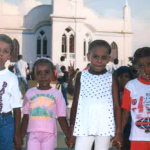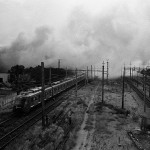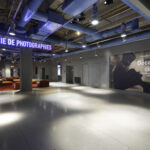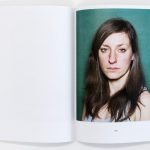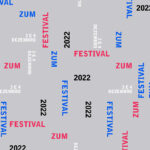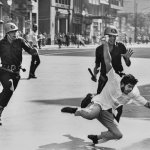The Guardian of History
Publicado em: 11 de September de 2013How a photographer for a provincial newspaper succeeded in documenting both the official and the hidden sides of Mao Zedong’s cultural revolution.
Li Zhensheng was just over 25 years old when he made a decision which he kept secret for almost 40 years, unrevealed to those around him. Working patiently and methodically, he tempered fear with hope, and deserves the thanks of 20th Century history. If we understand the word photography literally as meaning “writing with light”, he has profoundly illuminated our understanding of the Proletarian Cultural Revolution (1966-76), one of the most inflammatory, insane, catastrophic and complex periods in the history of China.
In 1968, Li took advantage of a crack in the floor of his apartment to excavate a small cavity. At the time he was working as a photographer for the local newspaper in Harbin, the capital of the bleak and freezing Heilongjiang province in the northeast of the country.
Working carefully at night so he wouldn’t arouse the suspicion of his neighbors, he increased the size of the crack using homemade sandpaper. Bit by bit, centimeter by centimeter, the crack became a hole. In this hand-dug hiding place Li preserved his illegal visual record of the so-called “10 years of chaos.” In total, he hid from three to five thousand negatives, which remained there, untouched, for two decades. When they finally began to emerge from their hidden sanctuary in the late 1980s, their creator was twice as old as when he started the collection.
However, the sheer size, importance and historical value of this material had to wait another two decades to be revealed. It was only in 2003 that the Briton Robert Pledge, co-founder of the Contact Press Images photo agency – and the Western guardian (albeit accidentally) of Li’s work – finished editing Red-Color News Soldier, his powerful and shocking book about the life and work of the photographer.
Since then a lot has changed for the Chinese photographer: a major exhibition which has toured the United States, Europe and Japan; visiting professorships at Harvard and Princeton; a group exhibition at the Barbican in London in 2012. Other changes, however, will have to await their moment: despite the major transformations in post-Maoist China, the book remains unpublished in Chinese. The past he depicts is still an unhealed wound in the present.
The Great Leap
Zhensheng is Li’s given name and has an auspicious meaning, something like “your fame will touch the four corners of the world.” Motherless from the age of three, Li was born in 1940 and raised by his father, who worked as a cook. He took Li to the movies almost every Sunday. Methodical and disciplined from an early age, Li filled a number of notebooks with notes on the films he saw. He learned the basics of photography as a teenager, and as soon as he could he enrolled at the Changchun Film School, which had a progressive approach for the period. If the reality of life had not trampled all over him, he would have become a film-maker, his first passion.
At the end of the 1950s, Mao Zedong, the supreme leader of the Chinese Communist Party, who had ruled the Republic of China since it was founded in 1949, decided to turn the country on its head. Mao decreed The Great Leap Forward, intending to drag the country from its backwardness. He demanded “three years of effort and hardship” from the population in exchange for “a thousand years of happiness.” First came the mass collectivisation of rural communities, which was carried out successfully. But the next step, which promised the country accelerated technological and urban modernisation, resulted in one of the most devastating human tragedies of modern times. It is estimated that between 18 million and 45 million Chinese died of starvation during the Great Leap.
In such times, to try to earn a living making films would be insane, and Li gladly accepted the position of photojournalist at the Heilongjiang Daily, the most important newspaper in the province, with a circulation of 270,000. He started in the newsroom in 1963 at the age of 23, when the Cultural Revolution was in its infancy. He only left it almost two decades later, when he was in his forties. He experienced the experiment that followed the Great Leap as both an ordinary citizen and as a photographer charged with recording the official history of the period.
Although part of the propaganda machine run by the Party and State, Li was not a member of any of the three social classes trusted by the government – he was not a member of the armed forces, an industrial worker nor a peasant. So he had hardly started work when he was forcibly enrolled in the Socialist Education Movement, which sent urban young people to rural areas. It was two and a half years of “re-education in the fields”, with daily immersion in readings from Chairman Mao’s Little Red Book. When he returned to his job at the Heilongjiang Daily in March 1966, two months before the official start of the Cultural Revolution, he was one of millions of young Chinese imbued with the fervour of “serving the people” and creating a more egalitarian society. He submitted himself willingly to self-criticism sessions with his colleagues and had his diary and love letters confiscated as part of the process of cleansing bourgeois impulses.
“At first, everyone was excited, including me,” he said afterwards, drawing attention to the dates when images from his collection showed scenes of joy and spontaneity: they all date from the first days of the Revolution.
It was a time when Chinese high school students spread out into the countryside to bring education to the people and medical students trecked to the most remote villages to provide basic care for the population. They believed that they were the vanguard of a movement which would eradicate China’s “revisionist and decadent” past. It was a naive moment of exciting social ferment, which did not last long.
History is littered with leaders capable of mobilizing the masses and shaping them into an instrument of power. Mao Zedong was right to look for what he wanted amongst young people. Wherever they are in the world, they are the part of humanity most open to ideas, committed and ready to embrace a radical cause. And they are the cruellest too, if necessary.
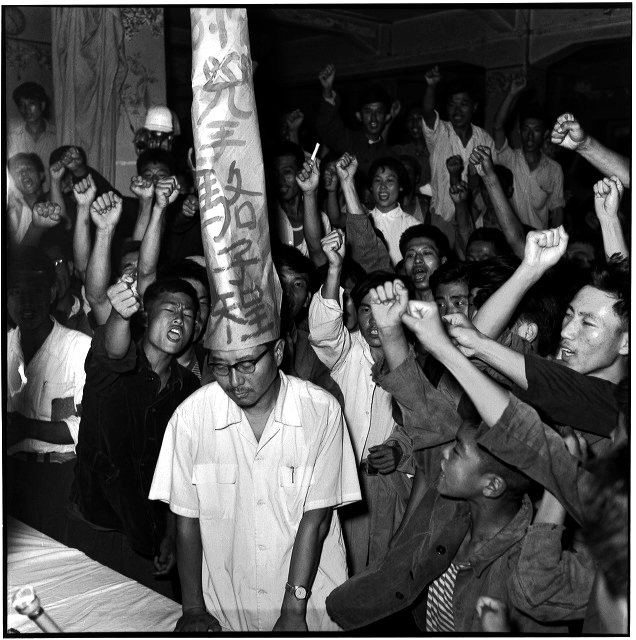
August 25, 1966; The staff of the Heilongjiang Daily, where the photographer worked, accuse luo Zicheng of following the capitalist line and opposing the movement of the masses. his crimes are inscribed on the hat. Harbin, Heilongjiang province
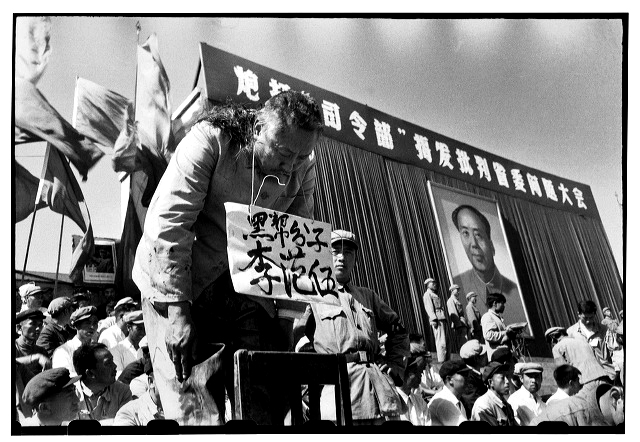
September 12, 1966; Governor Li Fanwu has his head shaved by Red Guard youngsters. Harbin, Heilongjiag province
The First Doubts
At the Heilongjiang Daily, it worked like this: for each photo published, the photographer earned the right to take eight photos of subjects of his own choice. But in order to be published, the image needed to be positive – Rabelaisian masses, ecstatic youngsters, Red Guards brandishing the Little Red Book, cheering peasants, scenes of public humiliation of those who have fallen from grace. Images that might be considered negative, such as of executions, in addition to being automatically discarded and incinerated, gave rise to criticism for the waste of film involved. The monthly allowance for each photographer was 15 rolls of 35 mm and 20 rolls of 120 mm.
Li headed out armed with a Rolleiflex fitted with an 80 mm lens and a Leica M3 with two lenses, plus the essential Red Guard armband which guaranteed that he could work without being harrassed. He developed a trick to inject revolutionary fervor into images of silent crowds: he practiced the best way to shout “Long live Chairman Mao” at home in front of the mirror, and repeated it before the crowd. Invariably he managed to capture an image of someone with a raised fist and open mouth. At the end of the day, it fell to him to develop the photographs taken by all his colleagues, as he was the youngest member of the team. He would sing to dispel the loneliness of the long evenings spent in the newspaper’s darkroom. He learned how to retouch and manipulate photos, inserting portraits of Mao where they were missing from the scene.
Li’s first doubts about the Revolution began in August 1966, while he was capturing the rage with which a group of young Red Guards destroyed the ancient Orthodox cathedral in Harbin, literally with their own hands. The next day, it was the turn of a Buddhist temple in Heilongjiang to be attacked, while the monks were publically humiliated. Li decided to photograph events from a different perspective – his own. “Ever since I was a film student I have known that nothing is more expressive than the face,” he recalls.
The customary position of disgraced citizens put on public display was always the same: facing the masses, back and head bowed, eyes on the floor with a heavy notice around the neck, vilifying them. It was not unusual for the penance to include wearing a long cone-shaped hat covered with offensive phrases, all aimed at increasing the degradation.
That significant day in 1966 Li told the monks lined up on a platform to raise their heads and look at the camera. He managed to capture an image of the group in rare individual movement and in some way return their identity and a little humanity. But it was only in 1968, when he witnessed the execution of seven men and one woman, that he made the decisive break with the Revolution. Six of the condemned convicts were common criminals. Two were accused of being counter- revolutionaries. After being subjected to the ritual of being condemned in a public square, they were loaded onto a truck and paraded through the city to the local cemetery. There, hands bound and forced to kneel, they were executed with shots to the back of the head. Li relates that he made the decision to photograph each of their faces from close-up. The images plagued him for months afterwards. And he could not forget the words of one of the accused, upon hearing his death sentence: “This world is too dark.” He began to talk to their souls.
The End of Innocence
Laboriously, he started to hide the photos which would be unacceptable to the authorities. Every night, he would first dry the frames which would certainly be considered critical of the Revolution and clipped them from the roll of film – fearing that colleagues would denounce him for squandering public resources with photos of no interest to the newspaper. The positive images were left on the line to dry. He inserted the ‘negative’ negatives into tiny manilla envelopes and secreted them away in a hidden compartment in his desk.
Yes, at that stage of the Cultural Revolution Li Zhensheng didn’t just have his own desk at the newspaper – he had a secretary and his own official seal. The initial phase of naive militancy had become threadbare and terror was becoming the new face of Maoist power. The goal was to eradicate from all of Chinese life the “forces of backwardness” and disinfect the ranks of the Communist Party from “enemies of the working class” – two concepts which were elastic enough to allow anyone and anything to be accused. In this constant, self-consuming process, in which each new group that emerged tried to show itself to be “redder” than the other, there was a constant flux of rise into grace and fall from power, without fixed rules. This endemic and corrosive violence, in which excesses became the rule, developed its own characteristics. While in the Stalinist Soviet Union purges and trials were deliberately carried out in secret, creating terror through silence, in China the humiliations of “bad elements” were always public. They were not intended to be seen as real deviations from the true path or crimes – they were propaganda. It was revolution through public spectacle, wrote the journalist Susie Linfield in The Cruel Radiance: Photography and Political Violence, published in 2010.
Li Zhensheng masterfully documented the cinematic dimension of this literally spectacular revolution. But he also maintained his focus on the individual within the masses. He succeeded in portraying humanity when annihilated by shame, by social opprobrium. His monumental works make the photographs of the period which we had access to seem pedestrian.
The Hideout
In the spring of 1968, Li began to take the little manilla envelopes home from their hiding place at the newspaper, sensing the possibility of a search at his workplace. He prepared their new hiding place carefully and patiently, opening a chink beneath the only table they had at home – a one-room apartment of 12 square meters (yes, 12) where he lived with his wife and young child. It had no running water, electricity or heating in a city where the average winter temperature ranges from -17 to -38 degrees Celsius (nowadays Harbin attracts tourists worldwide to its competitive Ice and Snow Sculpture Festival). While her husband sawed away, his wife kept a lookout on the street from their window.
Besides the envelopes containing thousands of negatives, the hiding place – no larger than a book – hid three stamps with the image of Goya’s Naked Maja and two coins depicting historical figures banned by the revolution.
As he had feared, he got caught up in the middle of yet another dispute at the newspaper over revolutionary dominance. Accused of being a member of the “new bourgeois” and a foreign agent, he suffered the agony of having his home searched – but the gap under the floorboards hiding the negatives was not discovered. He was exiled to a rehabilitation camp in a remote rural area near the border with the Soviet Union. He was subjected to two years of daily manual work, from the end of 1968 to 1970, which was intended to eradicate elitist tendencies from the camp’s inhabitants and replace them with socialist values. Every night, compulsory indocrination on the thoughts of the Great Leader.
Li emerged more mature from this second exile. Although he was considered rehabilitated and was promoted to the job of Director of Photography at the Heilongjiang Daily, his obsession with making a complete record of the Cultural Revolution, in both its positive and negative aspects, continued. But he did not anticipate that it would last another six long years – until the death of Mao Zedong in 1976 – leaving after-effects that are still unresolved in present-day China. He continued to photograph, with the intuition that all that material he squirreled away would someday be useful. He knew that he was witness to a unique moment in history and that he needed to go beyond merely recording events. So he tried, and succeeded, to understand the reality behind what he photographed.
A Superman
No-one better than this movie enthusiast and almost-filmmaker to capture the epic scale of that period. Li spent his formative years in regions bordering the Soviet Union, from which came the strong Russian cultural influence on his life and work. He was familiar with everything coming from that neighbor – from the literary masterpieces to the graphic art of socialist realism – and its rich cinematic output. He never fails to mention the impact caused by Sergei Eisenstein’s The Battleship Potemkin, readily visible in much of his panoramic photography.
Li himself says he photographed the Proletarian Cultural Revolution as if he was making movies. Working with cameras without zoom lenses, he darted around like mad so that he could capture the same scene up close, further away, and farther still in longshot, emulating the movements of a film camera. “If at that time I had had one of these (a digital Sony NEX-7 which he uses nowadays), I think I would have gone crazy,” he told the BBC. To get an idea of the physical effort required, it is enough to look at two pictures of a human multitude taken from the front and the rear during a memorial tribute to Comrade Mao at the stadium in Harbin.
The panoramas that Li produced are also enlightening. He photographed and put together the most grandiose scenes, crafting the panels himself. He captured the same scene in a number of sequential frames from left to right, panning across the scene with the camera held tightly to his body, always being careful not to use more frames than he needed. At night, he made contact prints and overlapped the frames in the order they were taken. He cut them as accurately as possible so that the images would merge and then stuck them together with tape. In this way he arrived at the composition he wanted, creating the illusion of a continuous image.
As is the practice of every photojournalist, Li always left one or two frames of his film unused, ready to capture any event of journalistic interest that he might encounter on his way back to the newspaper office. As it was rare for anything interesting to happen, he started to use the spare frames to photograph himself. These photos are remarkable for what they reveal. According to Robert Pledge, these selfportraits may be the way he found to liberate himself. A sort of path to self-knowledge.
Li says that these self-portraits were a way of making a film of himself. “In these photos, I was screenwriter, director, actor, cameraman – four roles in one.” Of that series, the image that usually causes most impact in the West is the one that shows him with his shirt wide open, revealing his chest in a Superman pose. The photographer denies that interpretation. “I didn’t even know who Superman was at the time. I just wanted to have a different kind of picture. I was bored with the way I usually looked.”
History Drop by Drop
Li moved from Heilongjiang to Beijing in 1982, when the Proletarian Cultural Revolution was buried, but not digested. He took on the position of professor of photography in the Department of Journalism at the University of Beijing, without revealing anything of the treasure he guarded. It was only in 1988, during a group exhibition entitled ‘Let History Tell the Future’, that he decided to show for the first time twenty images taken in 1966 and 1967. It was astonishing. Some colleagues from his time in Harbin who saw the show were dumbfounded. “Li, you recorded the whole story, we only recorded half of it,” one of them said.
As fate would have it, it was in that year of 1988 that Robert Pledge travelled to Beijing to curate three exhibitions. Li and Pledge established a trusting relationship and decided to start working on a book which would reveal the complete personal and professional odyssey of the photographer. It would be published when the political climate in the country became more amenable.
But they did not anticipate that this promising future would be further away than they imagined. A few months earlier, the army had opened fire on thousands of young demonstrators in China’s most revered space – the so-called Massacre of Tiananmen Square. That is when Li Zhensheng decided that his story was urgent. It was time to take the negatives out of hiding.
Bit by bit, he sent bundles and more bundles of the stored material to the New York office of Contact Press Images. Altogether, summing up both the “negative” and “positive” images, there were more than 30 thousand negatives, half of which the author had sorted and classified over the years with the help of his wife and daughter.
Red-Color News Soldier eventually arrived in U.S. and European bookstores in 2003. The title is the literal translation of the inscription on the Red Guard armband that he has kept until today. Since the publication of the book, the name Li Zhensheng has occupied the place it deserves in the history of photography. And history itself owes him due recognition as one of its guardians.
Today, married to the same woman with whom he went through all the Cultural Revolution, Li only uses his digital equipment to shoot photos of things that he likes – friends, places, family. “Nothing serious,” he says. He participates in photography festivals, lectures at universities, is working on two books and runs a blog about photography with 20,000 followers. He considers himself a patriot. Unlike the artist and political activist Ai Weiwei, he is not punished or persecuted in his own country, although a dozen of his own photographs illustrate the award-winning documentary Ai Weiwei: Never Sorry by Alison Klayman on the life and work of his contemporary, who was imprisoned for 81 days in 2011. Both share the same hope for the opening up of the democratic process in China.
Li Zhensheng is no longer afraid to show his work. “They are factual images, not fiction. I’m over 70 years old and have little to fear. Some accuse me of washing China’s dirty laundry overseas. That’s not it. I show a historical record of a mistake made by man against humanity.” In his view, everybody was a victim of the Cultural Revolution – the humiliated, the dead and those who inflicted these horrors on their comrades. ///
+
Red-color News Soldier, Li Zhensheng (Phaidon, 2003)
Ai Weiwei: Never Sorry (2012), a documentary by Alison Klayman;
The Cruel Radiance: Photography and Political Violence (2010), Susie Linfield, published by University of Chicago Press
images: © Li Zhensheng/Contact Press
Li Zhensheng was born in China in 1940. He graduated from the Changchun Film School and worked as a photojournalist for the Heilongjiang Daily. He taught photography at the University of Beijing and was a visiting professor at Harvard and Princeton universities. He currently works as a writer and researcher.
Dorrit Harazim is a journalist and former columnist for ZUM’s website.
///
Get to know ZUM’s issues | See other highlights from ZUM #4


